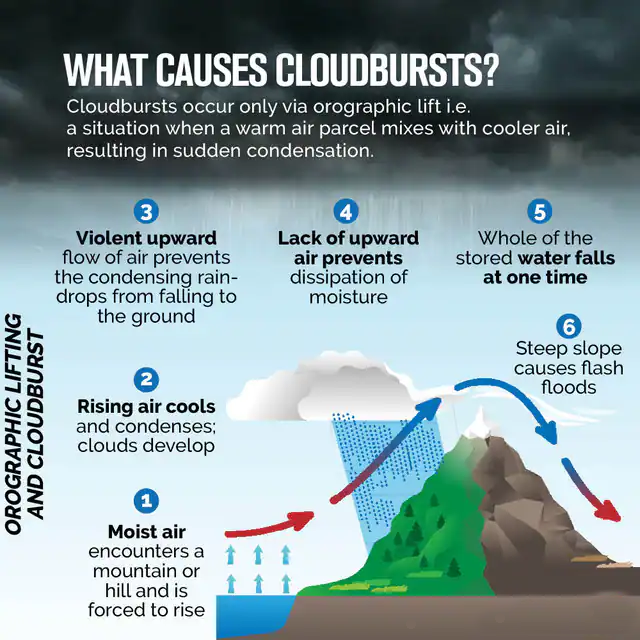-
14 Aug 2024
GS Paper 3
Disaster Management
Day 33: Explain the mechanism and occurrence of cloudbursts in the Indian subcontinent. What disaster management techniques are available to combat this hazard? (150 words)
Approach
- Provide a definition of cloudbursts.
- Explain the mechanism and occurrence of cloudbursts in the Indian subcontinent.
- Discuss the disaster management techniques are available to combat this hazard.
- Conclude Suitably.
Introduction
According to the India Meteorological Department (IMD), cloudbursts are sudden, heavy rainstorms where more than 10 cm of rain falls in less than an hour over a small area, of about 10 square km. They often happen in mountainous areas, especially in the Himalayas.
Body
Mechanism of Cloudbursts:
- Cloudbursts occur when strong upward currents of hot air prevent raindrops from falling, allowing them to grow larger while new smaller drops form below.
- This leads to a significant accumulation of water in the atmosphere, which is released abruptly when the upward currents weaken.
- Cloudbursts frequently occur in the hilly and mountainous areas of the Indian subcontinent, largely due to the region's complex topography, which facilitates orographic lifting.
- Orographic lifting occurs when air rises and cools as it travels up the windward side of a mountain.
- This process enhances cloud development and rainfall as moist air ascends over the mountains, with monsoon dynamics and localised weather patterns further influencing these intense precipitation events
Occurrence of Cloudbursts in the Indian Subcontinent :
- In the Indian Subcontinent, it generally occurs when a monsoon cloud drifts northwards, from the Bay of Bengal or the Arabian Sea across the plains then on to the Himalayas which sometimes brings 75 mm of rain per hour.
- Uttarakhand Cloudburst (July 2021): Devastating cloudbursts in Chamoli, Uttarkashi, and Pithoragarh caused flash floods, landslides, and extensive damage to infrastructure and lives.
- Himachal Pradesh Cloudburst (August 2020): Cloudbursts in Kullu, Lahaul-Spiti, and Kinnaur triggered landslides and flash floods, damaging roads, bridges, and houses.
Consequences of Cloudbursts :
- Flash floods: Flash floods are sudden, localised surges in water levels during or after intense rainfall.
- Flash flooding starts within 6 or 3 hours of heavy rainfall. It is typically caused by intense thunderstorms but can also result from dam or levee breaks and mudslides.
- Landslides: A landslide is a mass movement of material, such as rock, earth or debris, down a slope. It can happen suddenly or more slowly over long periods of time.
- In India, landslides account for about 8% of global fatalities, with 847 deaths and thousands displaced from 2001 to 2021, according to research from IIT-Madras.
- Around 13.17% of India’s area is susceptible to landslides, with 4.75% designated as "very highly susceptible."
- Mudflows: It is a type of water flow characterised by its high density and viscosity, containing significant amounts of suspended particles and silt.
- Mudflow can only transport and deposit the coarsest materials, leading to irreversible sediment entrainment, and it typically does not flow as far as regular water streams.
Disaster Management techniques to combat this hazard :
- Early Warning Systems: Develop effective early warning systems to predict cloudbursts and provide timely alerts, allowing people to prepare and evacuate if necessary.
- Urban Planning and Infrastructure: Invest in resilient urban planning and infrastructure, such as stormwater drainage systems, retention ponds, and green spaces, to manage excess water and reduce flooding.
- Watershed Management: Implement practices to manage watersheds, like reducing soil erosion and increasing soil infiltration, to help control water flow and lessen the impact of cloudbursts.
- Reforestation and Green Infrastructure: Plant trees and maintain green areas to absorb excess water, reduce soil erosion, and stabilise slopes, helping to mitigate cloudburst effects.
- Awareness and Education: Educate communities about cloudburst risks and train them on response and evacuation procedures to ensure they take necessary precautions.
- Sustainable Land Use Practices: Promote land use practices that reduce vulnerability to cloudbursts, such as avoiding construction in flood-prone areas, controlling deforestation, and implementing soil conservation measures.
- International Cooperation: Work with neighbouring countries and international organisations to share best practices, technology, and resources for managing cloudbursts, especially in shared river basins.
Conclusion
The occurrence of cloudbursts in India poses significant challenges due to their sudden and destructive nature. While early warning systems, community preparedness, and resilient infrastructure are key to mitigating their impact, challenges such as predictive limitations and topographical constraints need to be addressed. Continued investment in research, technology, and coordinated disaster management strategies is essential to protect vulnerable communities and reduce the devastating effects of cloudbursts in the Indian subcontinent.





